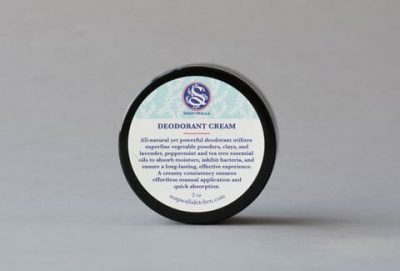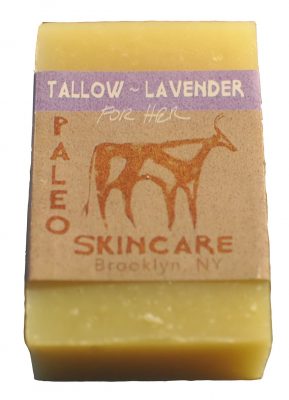
Written by Maia, President & Founder
In January of 2018, instead of making the usual resolutions that we’ve given up on by the end of the month, we decided to break it up by dividing some big goals into manageable chunks.
Each month, we invite you to overhaul one aspect of your life to reduce toxins, improve health, and increase your peace of mind. Our promise is that these changes will be easy to implement, helping you avoid resolution overwhelm.
(If you’re just joining us, here is January’s mini resolution on upgrading junk foods, February’s with a medicine cabinet detox, March’s on improving indoor air quality, April’s five ways to clean up your cleaning products, May’s on making your yard non-toxic, and June’s on water safety.)
Happy July! I want to dedicate this month to making over your collection of personal-care products. This is one of the our only mini resolutions that isn’t about your children; my bet is that most of you are much more careful about what you slather on their little bodies, and you are probably already using mostly Good Stuff on them.
So this month, I am going to recommend the best natural skincare products for the adults in your home.
Toxins in Skincare Products
As is the case with so many of the products we review on this site, synthetic fragrances are often the biggest offenders in skincare products.
Manufacturers don’t have to disclose exactly what’s in their fragrance blend. You’ll just see “fragrance” or “parfum” listed in the ingredients, but often this means dozens of chemicals, hormone-disrupting phthalates usually among them.
Other chemicals that you want to avoid in skincare products include:
- Synthetic preservatives, like parabens (benzylparaben, butylparaben, ethylparaben etc.), which mimic estrogen and are implicated in breast cancer. Other toxic preservatives include BHT and methylisothiazolinone. Food grade preservatives like potassium sorbate and sodium benzoate are somewhat controversial, but safer than their conventional counterparts.
- Chemical sunscreen ingredients like oxybenzone and octinoxate, both of which are endocrine disruptors. Safer sunscreen ingredients include titanium dioxide and zinc oxide.
- Foaming agents like cocamidopropyl betaine and sodium laureth sulfate (SLES), which is often contaminated with 1,4 dioxane, a suspected human carcinogen. Safer surfactants include lauramine oxide and sodium lauryl sulfate SLS).
(Read about the difference between sodium lauryl sulfate and sodium laureth sulfate here.)
Best Natural Skincare for Babies & Kids
This post focuses on the best natural skincare products for adults, but due to their small size and developing immune systems, babies and children are even more sensitive to toxins.
Swap out conventional hair- and skincare products for truly nontoxic options. These Safe Product Guides can help:
Best Natural Skincare Products For Grownups
Here’s my strategy for upgrading to the best natural skincare products: start with the stuff that stays on your skin for extended periods, that you use on large areas of your body, and that you use daily or almost daily. You’ll then move on to the adult personal-care products that you rinse off immediately, such such as soap.
The list that follows is in order of importance (deodorant is first because your shaved armpits make for easy-entry of the many toxins found in conventional antiperspirant brands).
Deodorant

Avoid these deodorant ingredients: parabens, fragrance, potassium alum
Safest brands: Soapwalla, Schmidt’s, Native
Read our Safe Deodorant Guide.
Body Lotion

Avoid these lotion ingredients: PEG chemicals, parabens, fragrance, benzyl alcohol
Favorite brands: All Good, Farmaesthetics, Seventh Generation
Read our Safe Lotion Guide.
Shaving Cream/Soap
 Avoid these shaving cream ingredients: fragrance, PEG chemicals, benzyl alcohol, potassium hydroxide
Avoid these shaving cream ingredients: fragrance, PEG chemicals, benzyl alcohol, potassium hydroxideFavorite brands: Dr. Bronner’s, Badger
 Body Wash
Body Wash
Avoid these body wash ingredients: BHT, cocamidopropyl betaine, fragrance
Favorite brands: Mama Suds, Dr. Bronner’s
Bar Soap

Avoid these bar soap ingredients:
fragrance, triclosanFavorite brands: Paleo Skincare, Christina Maser, FarmaestheticsRead our Safe Soap Guide.
Face lotions/toners/anti-aging products
Avoid these anti-aging ingredients:
 avobenzone, PEG chemicals, BHT, fragrance
avobenzone, PEG chemicals, BHT, fragranceHere’s my favorite anti-aging product, and this is the night cream I use.
Facial cleansers
 Avoid these face cleanser ingredients: PEG chemicals, fragrance, methylisothiazolinone
Avoid these face cleanser ingredients: PEG chemicals, fragrance, methylisothiazolinoneFavorite brands: Acure, Beautycounter , Farmaesthetics
Stay Sane,

P.S. This month we focused on skincare since I think that’s most important when it comes to personal care. Check the following posts for help with other personal care products:
Shop This Story
$16.95 — or subscribe and save up to 5%Buy Now
$14.95Buy Now
$9.99 — or subscribe and save up to 5%Buy Now
If you liked this post, sign up for our newsletter to be alerted when we publish new content like this!

 This post focuses on the best natural skincare products for adults, but due to their small size and developing immune systems, babies and children are even more sensitive to toxins.
This post focuses on the best natural skincare products for adults, but due to their small size and developing immune systems, babies and children are even more sensitive to toxins.


















Amanda says
Hi Maia – What do you think about Griffin Remedy? We have been using it for body and hair for years so curios to get your thoughts!
Maia James says
I don’t know that one but will look into it!
Alejandra says
Hi Maia!!!
What do you think about Shea Moisture brand??? I use baby & grownups products and would like to have your input!
Thank you
Maia James says
Mostly this is Good or Okay Stuff, with a couple exceptions!
Ana says
Hi Maia, i just have a question about the sunscreen. For what i undestand octinoxate is the ingredient that protects us from skin cancer. If we use sunscreen only with dioxide and zinc oxide is just to prevent sunburn. Do we have an alternative to protect us from skin cancer? Thank you.
John Goss says
Hi Ana,
John here…
The sunscreen issue is quite technical and tricky to get a grip on. It is not as simple as blocking one or the other. Sunscreens will undoubtably improve as we learn more but they must also not be responsible for detrimental unintended side effects. The following is from The Skin Cancer Foundation website…
The Skin Cancer Foundation considers SPFs of 15 or higher acceptable UVB protection for normal everyday activity, and SPFs of 30 or higher acceptable for extended or intense outdoor exposures. Such sunscreens also provide some protection against UVA wavelengths (320-400 nm), though the SPF rating refers only to UVB protection. Until 2011, no FDA-approved measurement standard existed for UVA protection in the US, even though such standards already existed abroad, and even though UVA penetrates more deeply into the skin than UVB, reaching the dermis. In the past, experts believed that UVB caused burning and skin cancer, while UVA caused photoaging, but the truth has proven more complex. In addition to producing sunburn, UVB can contribute to photoaging, and both UVA and UVB exposure can lead to skin cancer.
In June of 2011, the FDA issued its long-awaited new regulations for sunscreen labeling, including, for the first time, testing and labeling requirements for protection against UVA. These regulations will go into effect in December 2012, but products grossing under $25,000 in sales will have until December 2013 to comply with the new rules.
Sunscreens that meet FDA standards for both UVB and UVA protection may be termed “broad-spectrum,” a term that, until now, was frequently used but had no official meaning. Sunscreens may be labeled broad-spectrum if they provide “proportional” protection against both ultraviolet A (UVA) and ultraviolet B (UVB) radiation. In other words, a product with an SPF of 15 must have a comparable level of protection against UVA to be considered broad-spectrum.9 Newly standardized methods for measuring UVA protection made these improvements possible. Broad-spectrum sunscreens combine UVB- and UVA-absorbing chemicals and/or physical screens, and thus give the widest range of protection. As of December, 2012, broad-spectrum sunscreens with an SPF of 15 or higher will be able to state that they reduce the risk of skin cancer and early skin aging caused by the sun, if used as directed with other sun protection measures. Sunscreens that are not broad-spectrum or that have an SPF of 2-14 will be required to have a warning stating that the product has been shown only to help prevent sunburn, not skin cancer or early skin aging.
Gabrielle says
Hi Maia – can you do a review of tampons? Looking to make the switch to organic and would love to hear what your opinion is!
Suzanne Weaver-Goss says
yes, will add to the list!
asad says
thanks for sharing https://gimmethegoodstuff.org/best-natural-skincare-products/
Sophie says
Hello, Maia!
Thank you so very much for all your hard work in researching products and sharing what you have found! I’ve been trying to use toxin free products for about ten years now and I’m so glad to have found your website. I’ve learned that many of the products I was using were unfortunately sneaky stuff. I did want to get your expertise on the skincare product brand I’ve been using for a couple of years. It’s Pai Skincare, which according to their website, they only use mostly organic/natural ingredients and have many certifications. I was going to switch over to using Beauty Counter skincare since you recommend them so highly, but the ingredients seem a little better in Pai. Just curious what your thoughts were since I haven’t seen Pai on any of your good stuff lists (although I know with so many skincare lines out there you can’t research them all).
Thanks!
Sandra says
Hi,
I saw one of your posts on Beauty Counter and the makeup you like to use from them. Do you also recommend there skin care products?
Thank you.
Veronica says
Hello!
What do you think about the
Jane iredale makeup products?
Are they as clean as they claim?
Thank you
Emily Sheehan says
Good Morning Maia:
I had a quick question about one of the ingredients in several Farmaesthetics moisturizers. When reviewing the ingredient list I noticed that their lavender lotion (which you sell in your store) and their herbal cream contain borax. I am only familiar with this ingredient in uses like laundry detergent and a general household cleaner and I was always told that it was very irritating to skin and fairly toxic. Could you please explain why Farmaesthetics includes this in their product and if the product is safe for use by children and pregnant gals like myself 🙂